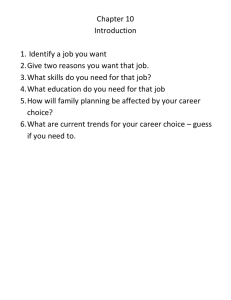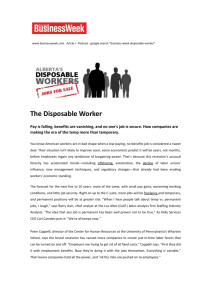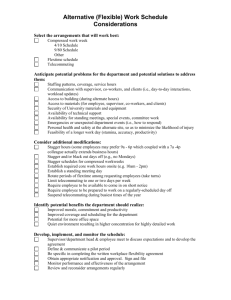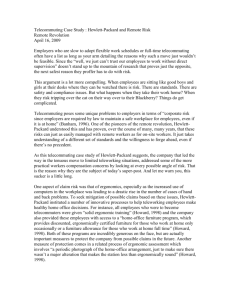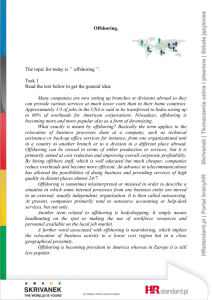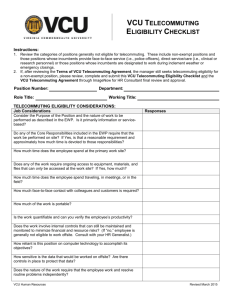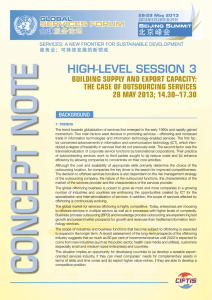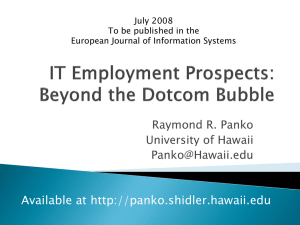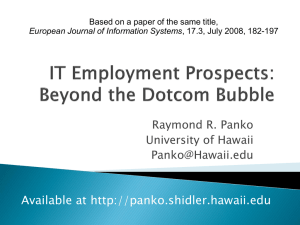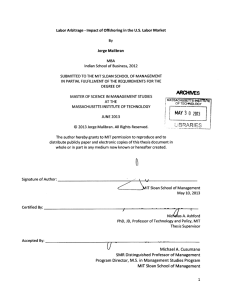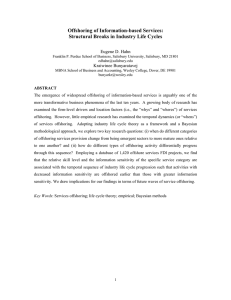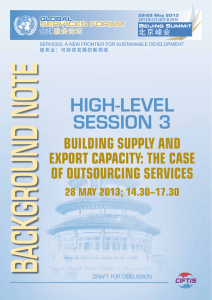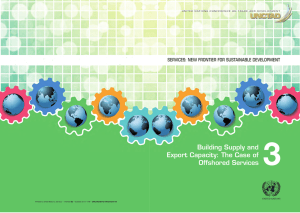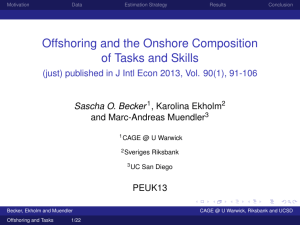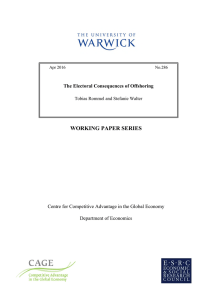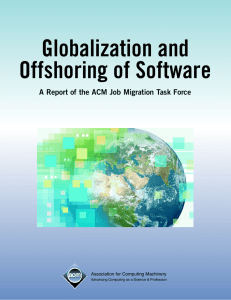Lecture 7: Economy and the Workplace
advertisement
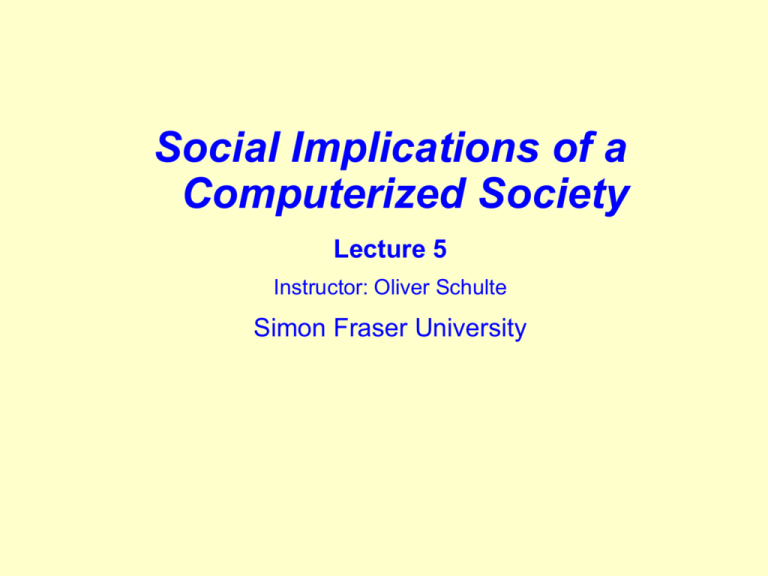
Social Implications of a Computerized Society Lecture 5 Instructor: Oliver Schulte Simon Fraser University What We Will Cover • • • • The Impact on Employment The Work Environment Employee Crime Employee Monitoring Concerns • The introduction of computers in the workplace generated many fears – Mass unemployment due to increased efficiency – The need for increased skill and training widens the earning gap • New trends still generating fears – Offshoring of jobs will lead to mass unemployment Offshoring company, Lou Dobbs on outsourcing – Employers use of technology to monitor their employees Example: Honeywell installs Encase software to monitor 10,000+ employee computers (copies of files, e-mail, etc.) Discussion Question • Are you worried about the effect of offshoring in our own job prospects? • Should be government do something to protect jobs for Canadians, e.g., require Canadian companies to “hire Canadian”? The Impact on Employment Discussion Questions • What jobs have been eliminated due to technology? • What jobs that were once considered highskill jobs are now low-skill due to technology? • What new jobs have been created because of technology? Economic View of New Technology: Existing Jobs • A successful technology eliminates or reduces some jobs. – Example: milking machines reduce need for milk hands. – Computers have reduced the need for telephone operators, meter readers, mid-level managers. • Old industries/services: Technology leads to productivity gains. – Productivity = output/time. – Basic decision for using productivity gain as a community: work less for same wealth, work the same for more wealth. • Individuals may lose jobs (e.g., milk hands). Economists’ answer: – retrain them to do jobs that are needed. – Temporary “transfer” of wealth to laid-off workers. – Question: does that happen enough in actual politics? – Question: What if the job is more than a way to earn money, e.g. a way of life (logging in B.C., fishermen in Quebec). – “The market does not respect lifestyles.” Job Losses that may have come from computer technology • Number of bank tellers dropped by 37% between ‘83 and ‘93. • Telephone operators dropped 60% between ‘70 and 2002. While longdistance callls increased from 9.8 bill to 94.9 bill. • Digital cameras: Kodak laid off thousands of employees. Economic View of New Technology: New Jobs • New industries arise – Internet – Cellular communications. • Lower prices increase demand and create jobs – Music industry changed from serving the wealthy to serving the masses, employing more than just musicians. Job Gains that may have come from computer technology • • • • • 1996: 100,000 new internet-related jobs. 1 1997: 109,000 jobs in cell phone industry. 1998: 242,000 jobs in chip-making industry. 2004: 10.5 mill jobs in U.S. IT. 2005: $1 trill spent on IT worldwide. Flexibility and Job Churn • Between 1993 and 2002, roughly 30 mill U.S. jobs were opened and closed each year. • There is a net increase of about 18 mill jobs. • Mark of a flexible economy. Discussion Question • Do you think there is too much flexibility in our economy (too much “hire and fire”)? Or too little? Winners and Losers from New Technology • Technology or Capital Owners win: Can produce the same or more with lower costs. • Workers gaining new job opportunities (e.g., in IT) win. • Customers benefit from lower prices. • Workers losing their job lose EI. Employment Trends: Are We Earning Less? • Are we earning less? – Since the 1970s, wages decreased but fringe benefits increased – Decrease in take-home pay may be due to other factors, e.g. • increased taxes • Rising income inequality • Globalization: more competition for workers. • Decrease of unionization, especially in U.S. – Purchasing power increases as prices fall. • Price fall mostly due to cheaper imports (e.g., China). • Housing prices have been going up. Employment Trends: Are We Working More? • Are we working more? – People work fewer hours since the Industrial Revolution. – But the average American worker puts in 200 hours more per year than in 1973 (J. Schor). – Tax law, benefits encourage overtime work rather than hiring additional workers. – One-earner per household used to be sufficient for middle class. – See recent sleep study. Free time the major concern in U.s. workers. – Is e-mail causing work stress? The Impact of Technology Unemployment rates fluctuate • Growth of computers has been steady, while unemployment has fluctuated widely. Hard to argue for connection one way or • another. Information technology supports globalization, offshoring (see next slide). Changing Skill Levels: • The new jobs created from computers are different from the jobs eliminated • New jobs such as computer engineer and system analyst jobs require a college degree, whereas jobs such as bank tellers, customer service representatives and clerks do not • Companies are more willing to hire people without specific skills when they can train new people quickly and use automated support systems • The computer can be a “cognitive prothesis”. The Impact on Employment A Global Workforce: • Outsourcing - phenomenon where a company pays another company to build parts for its products or services instead of performing those tasks itself • Offshoring - the practice of moving business processes or services to another country, especially overseas, to reduce costs • Inshoring - when another company employs thousands of people in the U.S. (e.g. offshoring for a German company means inshoring for U.S.) • Almost 5% of U.S. workers are employed by foreign companies The Productivity Paradox • Solow (1987): “You can see the computer age everywhere but in the productivity statistics”. • In the 1980s, IT investment grew 24%/year---productivity declined! • Many possible explanations offered - can you think of some? The Productivity Paradox 20 years later • Productivity Growth in 2001: 5.4%, 2002: 5.4%, 2003: 8.1%. • Possible Explanation: businesses have finally become more efficient through IT use. • Alternative explanation: how is output/time measured? – Time: U.S gvt says financial services workers work 35.5 hours as in 1988. Stanley Morgan: “That’s absurd---most information workers can work around the clock.” – Output: Hard to measure in services. Gvt uses workers’ compensation instead. • Alternative explanation: using cheap overseas labour. New Job Market Dynamics Getting a Job: • Learning about jobs and companies – Online company histories and annual reports – Job search and resume sites (monster.ca) – Online training • Learning about applicants and employees – Search online newsgroups and social networks – Hire data-collection agencies such as ChoicePoint – Prospective employees may craft an online profile and presence geared towards the job they want The Work Environment Job Dispersal and Telecommuting: • Telecommuting – Working at home using a computer electronically linked to one's place of employment – Mobile office using a laptop, working out of your car or at customer locations – Fulltime and part-time telecommuting Telecommuting: Benefits • • • • Reduces overhead for employers Reduces need for large offices Employees are more productive, satisfied, and loyal Reduces traffic congestion, pollution, gasoline use, and stress • Reduces expenses for commuting and money spent on work clothes • Allows work to continue after blizzards, hurricanes, etc. • Promoted by many people, CIO Insight Telecommuting: Problems • Employers see resentment from those who have to work at the office • For some telecommuting employees, corporation loyalty weakens • Odd work hours • Cost for office space has shifted to the employee • Security risks when work and personal activities reside on the same computer • Distractions Discussion Question • Do you want to telecommute? How much? Why? Changes in Business Structure Changing Structure of Business: • Average Decline in Size (1975-1985): 20%. • Increase in smaller businesses and independent consultants (‘information entrepreneurs’). • Correlation between IT use and small size. • ‘Mom and pop multi-nationals’, small businesses on the Web • Growth of large, multi-national corporations • Not all changes due to technology, could also be tax law. The Work Environment Discussion Questions • How has technology made entrepreneurship easier? Harder? Employee Crime • Embezzlement - fraudulent appropriation of property by a person to whom it has been entrusted • Trusted employees have stolen millions of dollars • Angry fired employees sabotage company systems • Logic bomb - software that destroys critical files (payroll and inventory records) after employee leaves • Theft by employees = $17.6 bill retail losses in 2005. Employee Monitoring Background: • Monitoring is not new – Early monitoring was mostly ‘blue-collar’ (factory) and ‘pink-collar’ (telephone and clerical) jobs – Time-clocks and logs – Output counts at the end of the day – Bosses patrolled the aisles watching workers Employee Monitoring (cont.) Data Entry, Phone Work, and Retail: • Data entry – Key stroke quotas – Encourage competition – Beep when workers pause • Phone work – Number and duration of calls – Idle time between calls – Randomly listen in on calls • Retail – Surveillance to reduce theft by employees Employee Monitoring (cont.) E-Mail, Blogging, and Web Use: • E-mail and voice mail at work – Employees often assume passwords mean they are private – Roughly half of major companies in the U.S. monitor or search employee e-mail, voice mail, or computer files. – Supported by software like Encase. – Most companies monitor infrequently, some routinely intercept all e-mail. – Over half have fired employees for e-mail/web use. – Microsoft: access private, password-protected folders on work computers. Employee Monitoring: legal aspects E-Mail, Blogging, and Web Use (cont.): • Law and cases – Electronic Communications Privacy Act (ECPA) prohibits interception of e-mail and reading stored e-mail without a court order, but makes an exception for business systems – Courts put heavy weight on the fact that computers, mail, and phone systems are owned by the employer who provides them for business purposes Employee Monitoring: Labour Relations E-Mail, Blogging, and Web Use (cont.): • Law and cases (cont.) – Courts have ruled against monitoring done to snoop on personal and union activities or to track down whistle blowers – Many employers have privacy policies regarding e-mail and voice mail – The B.C. Labour Relations Board sets rules and decides cases about workeremployer relations Employee Monitoring (cont.) E-Mail, Blogging, and Web Use (cont.): • Some companies block specific sites (e.g. adult content, sports sites, job search sites, social-network sites) • Employees spend time on non-work activities on the Web • Concerns over security threats such as viruses and other malicious software • Concerns about inappropriate activities by employees (e.g., harassment, unprofessional comment) - see NYT article. Employee Monitoring Discussion Questions • How much privacy is reasonable for an employee to expect in the workplace? • Under what circumstances is it appropriate for an employer to read an employee's email?


